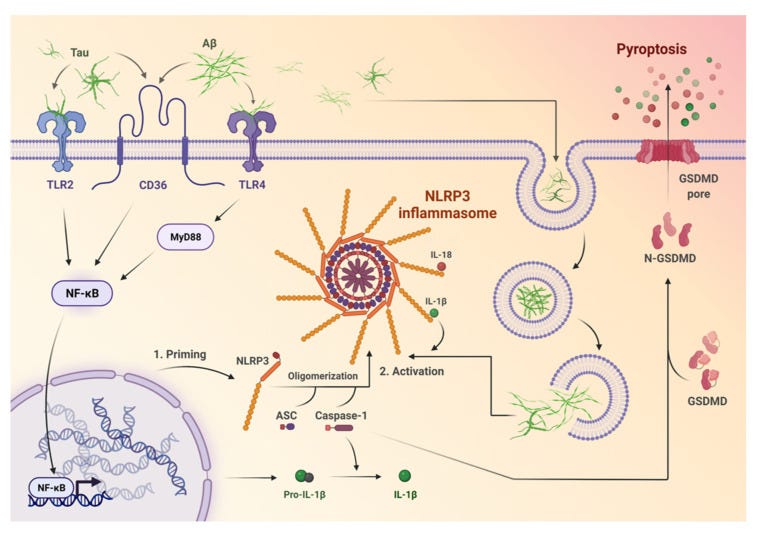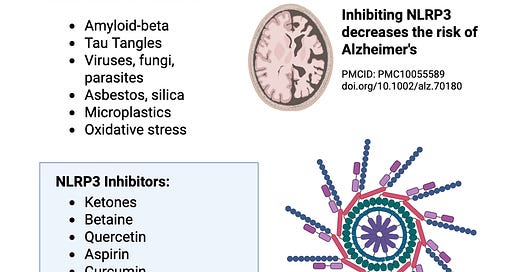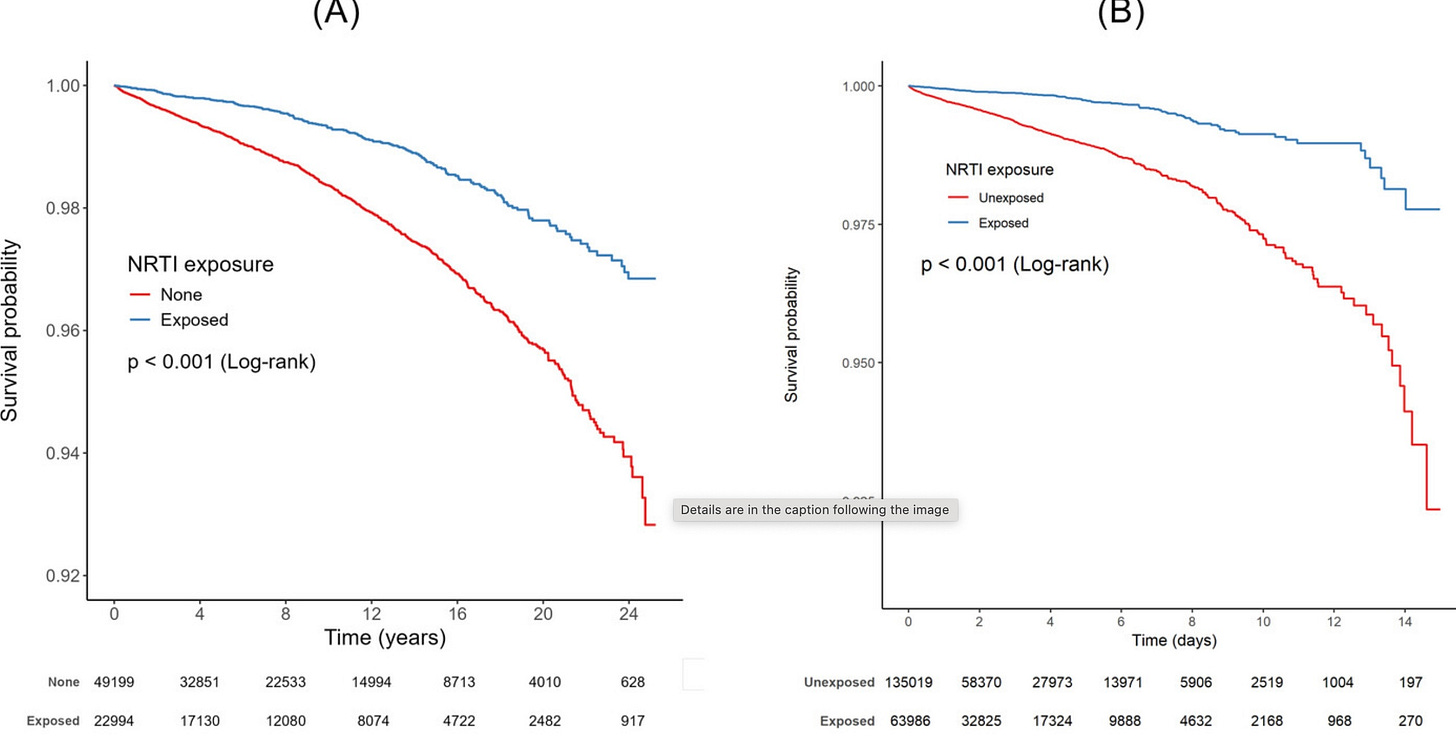Blocking NLRP3 to Decrease Alzheimer's Risk
How an AIDS drug reduces the risk of Alzheimer's - plus natural options that affect the same pathway
Studies involving large data sets on patients and the medications they use can shed light on pathways that influence Alzheimer’s risk, potentially pointing to realistic ways to reduce risk or even reverse the pathology.
The Alzheimer’s Association estimates that over 7 million people in the US currently have Alzheimer’s disease, and the projection is that the number will rise to over 13 million in the next 25 years. When it comes to healthspan, preventing Alzheimer’s should be a top priority for anyone who doesn’t have the APOE2 (protective) allele.
Blocking NLRP3 to prevent Alzheimer’s
A new study shows that the long-term use of nucleoside reverse transcriptase inhibitors decreases the risk of Alzheimer’s disease. Nucleoside reverse transcriptase inhibitors (NRTIs) are a class of anti-retroviral drugs used for HIV and hepatitis B.
The researchers used data from the VA and from health insurers, looking at people over age 50 who were on the drugs, as well as a matched healthy cohort. The data sets used involved 200,000+ patients over a 20+ year period, along with the matched cohort.
The results showed a significant decrease in the risk of Alzheimer’s disease that increased based on the years of medication usage. The VA data showed about a 6% decrease in Alzheimer’s disease (AD) risk per year of use of the reverse transcriptase inhibitors. The data from health insurance companies showed about a 13% decrease in risk per year of use. Both data sets had about 3/4 of participants with HIV and 1/4 with hepatitis B. Overall, there was a 37% decrease in the rate of Alzheimer’s in the patients on the NRTIs long term.
Here’s what the Alzheimer’s survival curves look like (blue line is people on NRTI):
Why is this so interesting?
The researchers think that the mechanism of action here is that the benefit is from the anti-retroviral drugs blocking the NLRP3 inflammasome (not from inhibiting reverse transcriptase).
A pre-print by the same authors included animal experiments that investigated the mechanism of action of the anti-retrovirals. The Alzheimer’s model mice given the nucleoside reverse transcriptase inhibitors had reduced amyloid beta deposits - and even reversal of Alzheimer’s symptoms. (I’m not sure why this part of their research didn’t make it into the newly published study, but perhaps they are publishing it as a second paper.)
It’s a real breakthrough if blocking the NLRP3 inflammasome can prevent Alzheimer’s or even reverse symptoms. This is a pathway that can be inhibited with natural supplements and current medications, to some extent.
Let’s dive into the research on how and why NLRP3 and increased neuroinflammation are so detrimental in the aging brain for Alzheimer’s and dementia.
What is the NLRP3 inflammasome?
Inflammasomes are multiprotein complexes that ramp up the activation of inflammatory responses and cell death. I think of it like a knob that turns up the volume on inflammation.
NLRP3 (NOD-like receptor, pyrin domain-containing 3 ) is key for the activation of the inflammasome, which is the part of the immune system responsible for activating the body’s inflammatory response system.
NLRP3 is found in the cytosol of cells, mainly macrophages and immune system cells, in an inactive form. [ref] When activated, NLRP3 binds together to form a big complex with another protein called ASC. This initiates an inflammatory response — like calling up the troops for a large inflammatory response.
So what activates NLRP3?[ref]
Viruses (e.g., adenovirus, influenza, Sendai virus, coronaviruses)
Specific fungi (e.g., Saccharomyces cerevisiae, Candida albicans)
Bacterial RNA (e.g., Listeria monocytogenes, Escherichia coli, Mycobacterium tuberculosis, and Staphylococcus aureus)[ref]
Certain parasites (e.g., Trichomonas vaginalis)[ref]
Asbestos and Silica[ref]
Damage-associated factors in the body (uric acid crystals, beta-amyloid plaque, extracellular ATP) and ROS (reactive oxygen species)
Microplastics [ref]
Researchers have known for a while that beta-amyloid plaque activates the inflammasome in glial cells and causes neuroinflammation. The generation of inflammatory cytokines, specifically IL-1β and IL-18, then increases amyloid-beta spread in the brain regions associated with Alzheimer’s. It’s like a cascade that drives more damage, eventually killing the neurons.[ref][ref]

Animal models of Alzheimer’s studied about NLRP3 inhibitors clearly show that blocking the inflammasome decreases AD pathology. [ref][ref]
How/Why is NLRP3 affecting Alzheimer’s pathology?
Amyloid-beta plaques and tau tangles are the hallmarks of Alzheimer’s.
It turns out that amyloid-beta is recognized by toll-like receptors on microglia, which directly triggers the NLRP3 inflammasome and IL-1β. Tau tangles also activate NLRP3 when they are taken into microglia. This sets off a cascade of inflammation in the brain, eventually leading to exacerbation of the amyloid pathology and neuronal cell death. [ref][ref][ref][ref]
If you want to go down a scary rabbit trail, the SARS-CoV-2 spike protein also activates the NLRP3 inflammasome in the brain.[ref]
Inflammation seems to be at the heart of neurodegenerative diseases. The biggest risk factors for Alzheimer’s include age (inflammation increases dramatically in old age), diabetes, hypertension, hyperlipidemia, and obesity — and all of these involve chronic, systemic inflammation. Studies have also shown that Alzheimer’s risk increases significantly due to air pollution (PM2.5), and this is also connected to NLRP3 inflammasome activation. Research also shows that viral infections in the brain, such as herpes simplex, may also be involved in Alzheimer’s and other forms of dementia. [ref][ref][ref]
Downregulating the NLRP3 response seems to be a key to inhibiting Alzheimer’s pathology, not only by decreasing inflammation but also because NLRP3 activation exacerbates the amyloid-beta plaque in a feedback loop.
Natural NLRP3 inhibitors:
While the data from the antiretroviral drugs is informative as to the long-term positive effect on Alzheimer’s risk, I don’t know that those medications are a good idea for everyone. Mouse studies are underway with strong NLRP3 inhibitors, but human trials are lacking. We are likely several years away from knowing the ins and outs of how much NLRP3 inhibition is needed and the effective duration and dose.
So let’s take a look at natural NLRP3 inhibitors, with the caveat that I don’t know how strong the inhibitory effect is (or what is needed).
Note that several of these already have known positive effects on Alzheimer’s or dementia.
Beta-hydroxybutyrate (BHB), which is generated naturally when in ketosis, decreases NLRP3 inflammasome activation. This could be why a ketogenic diet can be helpful in Alzheimer’s disease and other neuroinflammatory disorders. [ref][ref][ref]
Fasting or a very low-carb diet increases beta-hydroxybutyrate levels naturally. There are also supplements available, called ketone salts or BHB. Most come in powdered form as drink mixes with strong flavors to cover up the taste of BHB.
Betaine, also called TMG, is a form of choline that is important in brain health. Cell studies in Alzheimer’s brain cells show that betaine reduces inflammation by inhibiting the activation of the NLRP3 inflammasome.[ref] Betaine is found in foods like beets, spinach, wheat germ, rye, oat bran, and shrimp. It’s also readily available as a supplement. Look for TMG or betaine anhydrous on the label - not betaine HCl.
Vinpocetine inhibits the activation of the NLRP3 inflammasome. In animals, vinpocetine reduced inflammation from amyloid beta by blocking NLRP3 activation.[ref] Vinpocetine is available as a supplement, but it’s not something that I have any experience with. Be sure to check for interactions with medications.
Aspirin is an NSAID that inhibits NLRP3. Aspirin is also unique in that it can help with the formation of pro-resolving mediators, such as resolving D1, which tamps down NLRP3 inflammasome activation. In this case, it would be the combination of aspirin plus DHA from fish oil. Quercetin is another natural supplement that blocks NLRP3 activation. An animal study showed that the combination of aspirin and quercetin was more effective than either alone in reducing NLRP3 inflammasome activation.[ref][ref][ref][ref] Obviously, low-dose daily aspirin is not for everyone, so talk with your doctor if you have questions about it. However, if you are a good candidate for taking aspirin at least periodically, you could consider stacking it with DHA/EPA or with quercetin.
Curcumin has been shown in studies to reduce NLRP3 activation in the hippocampus.[ref][ref] Curcumin is readily available as a supplement. You can get it in capsules or in softgels that include coconut oil for better absorption.
Glycyrrhizin and isoliquirtigenin from licorice root are also natural inhibitors of NLRP3.[ref] Licorice root is available as an extract, or you can use the dried version to make licorice tea. This is a nice option if you like the flavor of licorice.
In addition to the antiretrovirals from the new study, other current medications may decrease NLRP3 inflammasome activation. For example, GLP-1 receptor agonists, such as Ozympic/Wegovy, decrease NLRP3 and amyloid-beta in animal models of asthma. GLP-1 RAs have also been shown to decrease the risk of Alzheimer’s in diabetic patients.[ref] [ref] SGLT2 inhibitors, another type of diabetes medication, have also has been shown to reduce amyloid beta and tau tangles through inhibiting NLRP3.[ref]
What are the drawbacks to blocking NLRP3?
The NLRP3 inflammasome is an important part of the immune response to certain pathogens, but there is also a lot of redundancy built into our immune system when it comes to most bacterial and viral pathogens. Infections with parasites are one area where the NLRP3 inflammasome may be more critical. For example, Toxoplasma gondii infection (from cat feces) activates NLRP3.[ref]
Conclusion:
More studies need to be done to determine the best timing and amount of NLRP3 inhibition. However, the study showing the overall reduction in Alzheimer’s risk with anti-retrovirals is a strong indicator that longer-term inhibition of NLRP3 is effective in reducing the risk of Alzheimer’s significantly. I would also love to see this type of analysis broken out by APOE genotype.






